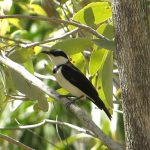BANDED HONEYEATER
The Banded Honeyeater is a small and striking bird. It measures about 12 to 14 centimetres in length. Its most distinctive feature is the bold black band that stretches across its chest, contrasting beautifully with its predominantly white underparts. The rest of its plumage is mostly black, including its head and wings, with a hint of iridescence that shimmers in the sunlight. This striking appearance makes it quite easy to spot among the foliage.
The Banded Honeyeater is predominantly found in northern Australia, particularly across the tropical savannas and woodlands. It favours areas where eucalyptus trees are prevalent, as these trees provide both food and nesting sites. During the wet season, these birds may migrate to other regions in search of flowering plants. Despite their small size, these birds are quite resilient, capable of travelling significant distances in search of food, especially during times when flowers are scarce.
As its name suggests, the Banded Honeyeater has a sweet tooth—or rather, a sweet beak. It primarily feeds on nectar, using its specialised brush-tipped tongue to lap up the sugary liquid from flowers. Eucalyptus blossoms are a favourite, but it will also feed on insects and spiders, which provide essential proteins, especially during the breeding season. The Banded Honeyeater is an important pollinator, playing a vital role in the ecosystem by helping to fertilise flowers as it feeds on nectar.
The breeding season for the Banded Honeyeater typically aligns with the wet season, when food is abundant. Their nests are small, cup-shaped structures made from grass and bark, often lined with soft materials like feathers. These nests are usually built high in the trees, well hidden among the leaves. The female lays two to three eggs, which she incubates for about two weeks. Both parents are involved in feeding the chicks once they hatch, ensuring they grow quickly and fledge within another two weeks.
While specific data on the longevity of the Banded Honeyeater is limited, small passerine birds like these typically live for about 5 to 10 years in the wild, depending on environmental conditions and predation pressures.
The Banded Honeyeater has a delightful array of vocalisations. Its calls are typically high-pitched and melodious, often described as a series of tinkling notes. These calls are used for communication between mates and to establish territory during the breeding season.
Unlike some other honeyeaters, the Banded Honeyeater is less aggressive, often seen feeding alongside other bird species without much conflict.




